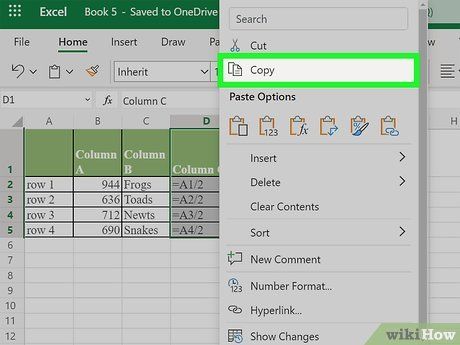5 Ways to Vertically Copy Paste in Excel

To enhance productivity and save time while working with Microsoft Excel, understanding how to vertically copy and paste can be a game-changer. This method allows you to duplicate data from a column quickly and efficiently. Here are five practical ways to do so:
1. Using Drag-and-Drop Method

The drag-and-drop method is one of the simplest and most intuitive ways to vertically copy data in Excel:
- Select the cells you want to copy.
- Hover over the edge of the selection until the cursor changes to a cross-arrow pointer.
- Drag the selection down while holding the left mouse button. Release it where you want to paste.
💡 Note: Ensure you drag in a straight line down to maintain vertical alignment.
2. Keyboard Shortcuts

For those who prefer keyboard navigation, here are some shortcuts to vertically copy:
- Select the range of cells you wish to copy.
- Press Ctrl + C to copy.
- Move the cursor to the first cell where you want to paste.
- Press Ctrl + V to paste.
🖱️ Note: Excel recognizes your action when you paste into a new location, so there’s no need to manually highlight the destination cells.
3. Using Paste Special

The 'Paste Special' feature offers a lot of flexibility:
- Copy the data with Ctrl + C.
- Right-click on the destination cell, then choose 'Paste Special' from the context menu.
- In the dialog box, select Values, Formats, or Formulas depending on what you want to copy.
- Click OK.
🔍 Note: Paste Special is particularly useful when you only want to copy certain aspects of the data.
4. Using Fill Handle

The fill handle is a small square in the bottom-right corner of the cell selection. Here’s how to use it:
- Highlight the cells to be copied.
- Move your cursor over the fill handle until it turns into a plus sign.
- Click and drag down to fill or copy the data vertically.
📈 Note: By default, Excel will fill the data with increments or repeats, but holding Ctrl while dragging will copy the exact values.
5. Applying Excel Formulas

Using formulas to replicate data can be efficient, especially for large datasets:
- In the cell where you want to start copying, enter a formula like:
=A1
📚 Note: Adjust the formula if you're copying from a different column.
Understanding how to vertically copy and paste data in Excel not only increases your efficiency but also allows for more dynamic spreadsheet creation. These methods cater to different situations, from simple data duplication to complex data manipulation, ensuring that you always have a tool at hand for any task.
In Conclusion

Mastering the art of copying and pasting vertically in Excel opens up a world of possibilities. Whether you're organizing data, performing repetitive tasks, or setting up complex data models, these five methods ensure you're equipped to handle your spreadsheets with ease. Remember, choosing the right method depends on the specific task at hand, your comfort with Excel, and the complexity of the data you're dealing with. Each technique has its unique benefits, so explore them, understand them, and make them a part of your Excel skillset.
What’s the difference between using Ctrl + C / Ctrl + V and drag-and-drop in Excel?

+
Both methods will copy the selected cells, but drag-and-drop is more intuitive for quick copy-paste actions, while Ctrl + C / Ctrl + V offers more control when you need to paste into different spreadsheets or worksheets.
Can I use Paste Special to copy only specific elements like formulas or formatting?

+
Yes, Paste Special allows you to copy formulas, values, formats, comments, and other data attributes selectively. This is particularly useful for maintaining data consistency and formatting across your workbook.
What are the limitations of the fill handle when copying?

+
The fill handle copies the content but may not always preserve the original format or formulas. Also, if there’s an existing pattern in the data, Excel will attempt to continue that pattern rather than directly copying the values.
Is there a way to prevent Excel from auto-filling formulas when copying vertically?

+
Yes, use the symbol to anchor the row or column reference in your formula. For example, if you want to copy a formula from cell A1 to all cells below it, but always referring to A1, use =A1 in your formula.
How can I quickly copy a range of cells from one worksheet to another?

+
Copy the cells using Ctrl + C, navigate to the destination worksheet, select the top-left cell where you want to paste, and use Ctrl + V. If you want to copy to a specific range, highlight that range before pasting.